| << UbuWeb |
| Aspen no. 1, item 6 |
|
|
| The Hide-and-Seek Bird of the Timberline |
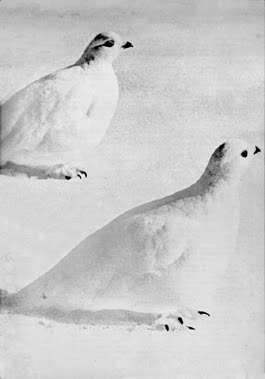
|
The White-Tailed Ptarmigan: The Hide-and-Seek Bird
by Timothy Thomas and Tony Gauba If you see one in the winter, and at 11,000 feet it's unlikely you will, you'll probably first perceive it as an ordered pattern of eyes, beak and claws, black against a white field, like sumi strokes on rice paper. It virtually vanishes into its snowbound habitat on the timberline. White on white: snow-white against snow, fog-white against winter fog and clouds as it flies in long, skipping glides like a flat stone scaled across water. |
|
In the spring as the snow melts, it disappears into another color scheme. One naturalist spent nine seasons searching for a nesting hen and never saw one, although he knew they were on the ground all about him, more earthlike than the earth. Mottled sepia and sienna blending into patches of white. Wyeth color. The white-tailed ptarmigan or "snow quail" as the miners used to call them. The hide-and-seek bird that has perfected the art of protective coloration. A species of grouse in habiting the barren high country, the vertebrae of the Rockies from northern New Mexico up through Aspen country to southern Alaska. You have to climb high to see it. In summer it lives in the peaks and ridges above the tree line, up to 14,000 feet. In winter it descends to the sheltered lower basins and timberline areas in search of food. In captivity, it dies. It's roughly the size of a pigeon — 12 to 13 sleek inches from beak to tail — and in winter plumage it takes on the grace and beauty of Picasso's peace dove. It's the only ptarmigan (pronounced tar-muh-gun) found in the U.S., its white-tipped tail distinguishing it from the willow and rock ptarmigan of Canada, Alaska and Europe. The ptarmigan feels so secure in its camouflaged plumage, it is remarkably unafraid. It is commonplace for hunters to stand a few feet from a ptarmigan crouching silently on the rocky tundra and not see it. Hikers have almost stepped on it. Some call it "courageous." Some "foolish." Depends how you look at it. When approached, the ptarmigan usually crouches unmoving and close to the ground as long as the object of danger is moving. But let the pursuer stop, the bird tries to steal away, revealing itself to the gunsight or wolf jaws. This stealthful movement almost succeeds in combining action with rigidity of pose as with painful slowness one foot is advanced ahead of the other, sometimes as little as three steps to the minute. If the pursuer starts to move, the bird "freezes" again. |
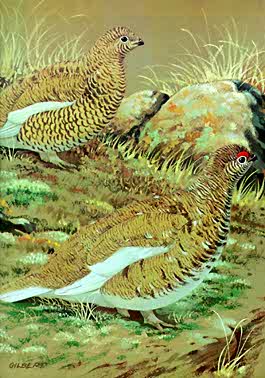
|
|
The miners claimed they used to kill them with sticks. However, if hunted persistently, the ptarmigan will soon become spooky and wild and depend more on hasty escape than on motionless camouflage. Nature provides protective coloration to many species but the ptarmigan seems to have developed a dual personality to capitalize on it. In mottled summer plumage, the ptarmigan will scurry fearfully across patches of snow, but when strutting indistinguishably among lichen-covered rock matching its plumage, the bird is tame and unperturbable. In winter white, its behavior is reversed. It avoids bare soil and rocks, and frantically runs over snowless patches as though realizing how vulnerable it is in its white plumage. But in snow, the ptarmigan feels so protected you almost have to touch it to make it move. In another remarkable adaptation to its alpine environment, the white-tail grows its own snowshoes. Its legs are feathered to the claws. Long, hairlike feathers enabling the bird to move quickly across soft, powdery snow without sinking in—like a water spider on a mill pond. In fact, the ptarmigan's plumed legs give the bird its scientific name: Lagopus—from the Greek Lagopous, or foot of the hare. The analogy becomes more striking in summer as the rocky terrain wears down the feathers, giving the claws the look and texture of a rabbit's foot on a key ring. 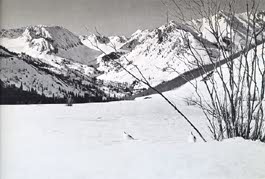
For grandeur of outlook, ptarmigan-land is hard to equal, but it's a harsh environment where few birds can survive. The ptarmigan does it by matching its plumage to the seasons. It's a disappearing act so successful that many naturalists tell the same story: almost stepping on the bird — particularly a nesting hen — right while searching the ground for one. 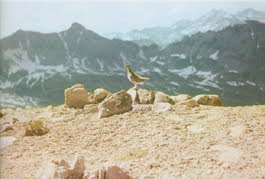
|
A ground-dwelling bird, the white-tail is more agile on foot than in the air. If stalked from above, its tendency is to fly away from the trouble, but if approached from below, it will run uphill, like most mountain game, leaping nimbly from rock to rock, stopping frequently to check on its pursuer. The bird seems amazingly agile to a two-footed tracker who is soon gasping and weak-legged in the thin high-altitude air. After a short pursuit, he usually is happy to sit on a rock and admire the panorama of this ptarmigan paradise—long, sunny slopes of tundra, broken by alpine meadows patchworked with flowers, 40 or more varieties, all trimmed low by the constant winds. A few sorry conifers, stunted and twisted in their unequal struggle with the elements. Off on the horizon rises the jagged spine of the nation, the Continental Divide. Down below lies an alpine lake tucked in the fold of a mountain, and everywhere, a blissful silence broken only by wind voices. It's one of the most magnificent environments of any living creature—and one of the harshest. Here, few can survive. Bleak as is the world that high up, the ptarmigan manages to find a varied diet: grass seeds, insects, berries, small leaves and buds of the arctic willow, flower buds, even lichen. In winter, the choice narrows down to knotted buds and naked twigs of the willow. Probably because there are no trees in its highland habitat, the ptarmigan flies in a straight series of long, low glides, with no dodging or swerving. It seldom flies far, usually settling down within a couple hundred yards, perhaps aware that safety remains on the ground, since in flight it is as conspicuous as a low-flying blimp. Protection from weather is another matter. In the high country where the wind blows long and hard, the white-tailed ptarmigan has learned to nestle behind rocks, beak to the wind, protected by the insulation of its dense feathers as the wind slipstreams over its smooth body. In really bad weather it burrows into the snow, plummeting into the bank on the fly, like a snowball, thus leaving no telltale trail for a predator to follow. And predators it has many, from hawks to mountain lions. The game of life and death is never ending in the high country, with the weak ever hiding and the strong ever searching in the baffling ice-bound white. Its protective coloration is especially essential at nesting time, since it enables the whitetail to nest on the ground in an environment so barren it has scarcely a shrub for cover. The nest itself is a pathetic thing—a shallow saucer-like depression in loose, rocky soil, some five inches in diameter and an inch deep. It is lined with whatever is handy—grass stems, twigs and leaves, perhaps some feathers. The hen usually lays from four to ten beige eggs, brown-speckled, although as many as sixteen in a nest have been reported. The nesting hen develops a plucky, persistent disposition as she determinedly stays on her nest no matter what man and nature may devise. She lays her eggs from mid-June to mid-July so a late snowstorm frequently covers the nest. No matter, she gamely persists in incubating those eggs. One hen stoicly stayed on her nest for three days, although covered with 18 inches of snow, igloo fashion. The nesting hen displays similar fortitude even with two-footed intruders. One ornithologist reported a nesting hen so immovable he actually patted her on the head. Her only response was subdued clucking! A monogamous pair, the hen does all the incubating while the male remains protectively nearby, clucking and hooting so loudly he frequently gives the nest away. When the young hatch, the male helps feed and rear them, then goes his own way. |
|
For their part, the precocious chicks need little parental help. Clumsy, downy fluffs, they run in an hour and fly within two weeks of hatching; hence the old sourdough's tale that they fly with bits of eggshell clinging to them. Although it is virtually impossible to flush a hen from her nest, she develops a more bellicose personality after her brood hatches. Bob Terrell, wildlife conservation officer for the Aspen area, relates how extremely aggressive the hen can be. Furious females have knocked his glasses off by flying directly into his face. The cocks are combative, too, and a willow bush will fairly explode as a ptarmigan male flies out with a clattering racket of harsh notes and whir of wings to protect his family. Sometimes a ptarmigan, like other grouse, will "feign" a broken wing to distract attention from its brood. However, ethologists now suspect that this "broken wing decoy behavior" is not just a clever and gallant act, but results from confusion between a parental urge to stay with the offspring and an equally strong urge to escape by flying. Although no songbird, the ptarmigan is a talkative species with a variety of call notes ranging from the soft cluck of the brooding mother to the shrill crowing of the male. The female also cackles like a barnyard hen. When undisturbed, parent and young converse almost continually, with mother doing most of the talking. In May or June, courtship cackles are heard on every peak as the ptarmigan separate into pairs and the cycle begins again. Courtship antics lack the booming and strutting and fancy footwork of the other grouse—the male white-tail preferring simply to flap his wings pompously and cackle and puff up the brilliant comb which curves over each eye like a red eyebrow. The female acts merely bored by the proceedings. In September, with the smell of snow in the air, molting into winter white begins and the birds assemble in small flocks to spend the winter together. To the sharp-eyed Aspenite, a glimpse of the white-tailed ptarmigan in the fall provides a look into the future: If the ptarmigan takes on its pure white plumage early—a phenomenon occurring this fall and last—the Aspenite knows he's in for an early, long and hard winter. And as Aspenites will testify, last year at least the white-tailed ptarmigan wasn't wrong. |
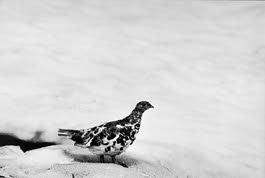
Hey, what's going on here? A ptarmigan in summer plumage scurries fearfully across a snow field to reach some lichen-covered rocks which will match his patchwork plumage. Conversely, a winter ptarmigan, which has wandered below the snowline in search of food, looks about in alrm as though aware of how he is limelighted against the rocks. 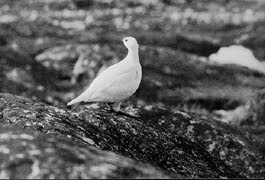
|
|
Original format: 12-page booklet, 9 inches by 12 inches. Photo credits: O.S. Pettingill Jr., Allen Cruickshank from the National Audubon Society, Loey Ringquist, Bob Terrell. Two photos are omitted here to reduce download time. |
|
|
|
|
|
|
|